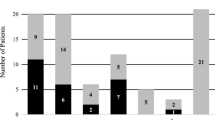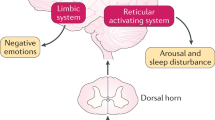Abstract
Purpose
The use of opioids for management of cancer-related pain has increased significantly and has been associated with a substantial rise in rates of substance abuse and diversion. There is a paucity of data not only on the prevalence of substance abuse in cancer patients, but also for issues of drug use and diversion in family caregivers. This study aimed to evaluate the frequency of risk factors for substance abuse and diversion, and abnormal urine drug screens in cancer patients receiving palliative care.
Methods
A retrospective chart review was performed for patients with cancer who were seen in the University of Virginia Palliative Care Clinic during the month of September 2012. We evaluated Opioid Risk Tool variables and total scores, insurance status, and urine drug screen results.
Results
Of the 114 cancer patients seen in September 2012, the mean Opioid Risk Tool score was 3.79, with 43 % of patients defined as medium to high risk. Age (16–45 years old, 23 %) and a personal history of alcohol (23 %) or illicit drugs (21 %) were the most common risk factors identified. We obtained a urine drug screen on 40 % of patients, noting abnormal findings in 45.65 %.
Conclusions
Opioids are an effective treatment for cancer-related pain, yet substantial risk for substance abuse exits in the cancer population. Screening tools, such as the Opioid Risk Tool, should be used as part of a complete patient assessment to balance risk with appropriate relief of suffering.

Similar content being viewed by others
References
SAMHSA (2013) Results from the 2012 National Survey on Drug Use and Health: summary of national findings: NSDUH Series H-46, HHS Publication No. (SMA) 13-4795. Center for Health Statistics and Quality, Rockville, MD
CDC (2013) Overdoses of prescription opioid pain relievers—United States, 1999-2008. Vital Signs. Atlanta GA
Governale L (2010) Outpatient prescription opioid utilization in the U.S., years 2000–2009. http://www.fda.gov/downloads/AdvisoryCommitteesMeetingMaterials/Drugs/AnestheticAndLifeSupportDrugsAdvisoryCommittee/UCM220950.pdf. Accessed 01 Nov 2013
Okie S (2010) A flood of opioids, a rising tide of deaths. N Engl J Med 363(21):1981–1985
Paulozzi LJ, Ryan GW (2006) Opioid analgesics and rates of fatal drug poisoning in the United States. Am J Prev Med 31(6):506–511
Bohnert ASB, Valenstein M, Bair MJ et al (2011) Association between opioid prescribing patterns and opioid overdose-related deaths. JAMA 305(13):1315–1321
Swarm RA AA, Anghelescu DL, Benedetti C, Buga S, Cleeland C, Deleon-Casasola OA, Eilers JG, Ferrell B, Green M, Janjan NA, Kamdar MM, Levy MH, Lynch M, McDowell RM, Moryl N, Nesbit SA, Paice JA, Rabow MW, Syrjala KL, Urba SG, Weinstein SM, Dwyer M, Kumar R (2013) Adult cancer pain. J Natl Compr Cancer Netw 11(8):992–1022
Cleeland CS, Gonin R, Hatfield AK et al (1994) Pain and its treatment in outpatients with metastatic cancer. N Engl J Med 330(9):592–596
Bruera E, Moyano J, Seifert L, Fainsinger RL, Hanson J, Suarez-Almazor M (1995) The frequency of alcoholism among patients with pain due to terminal cancer. J Pain Symptom Manag 10(8):599–603
Dev R, Parsons HA, Palla S, Palmer JL, Del Fabbro E, Bruera E (2011) Undocumented alcoholism and its correlation with tobacco and illegal drug use in advanced cancer patients. Cancer 117(19):4551–4556
Childers JW, Arnold RM (2012) “I feel uncomfortable ‘calling a patient out’”: educational needs of palliative medicine fellows in managing opioid misuse. J Pain Symptom Manag 43(2):253–260
Anghelescu DL, Ehrentraut JH, Faughnan LG (2013) Opioid misuse and abuse: risk assessment and management in patients with cancer pain. J Natl Compr Cancer Netw 11(8):1023–1031
Chou R (2009) 2009 Clinical guidelines from the American Pain Society and the American Academy of Pain Medicine on the use of chronic opioid therapy in chronic noncancer pain: what are the key messages for clinical practice? Pol Arch Med Wewn 119(7–8):469–477
Michna E, Ross EL, Hynes WL et al (2004) Predicting aberrant drug behavior in patients treated for chronic pain: importance of abuse history. J Pain Symptom Manag 28(3):250–258
Chou R, Fanciullo GJ, Fine PG, Miaskowski C, Passik SD, Portenoy RK (2009) Opioids for chronic noncancer pain: prediction and identification of aberrant drug-related behaviors: a review of the evidence for an American Pain Society and American Academy of Pain Medicine clinical practice guideline. J Pain 10(2):131–146
BJA. Prescription drug monitoring program. 2013; https://www.bja.gov/ProgramDetails.aspx?Program_ID=72. Accessed 01 Nov 2013
Webster LR, Webster RM (2005) Predicting aberrant behaviors in opioid-treated patients: preliminary validation of the Opioid Risk Tool. Pain Med 6(6):432–442
Butler SF, Fernandez K, Benoit C, Budman SH, Jamison RN (2008) Validation of the revised Screener and Opioid Assessment for Patients with Pain (SOAPP-R). J Pain 9(4):360–372
Akbik H, Butler SF, Budman SH, Fernandez K, Katz NP, Jamison RN (2006) Validation and clinical application of the Screener and Opioid Assessment for Patients with Pain (SOAPP). J Pain Symptom Manag 32(3):287–293
Butler SF, Budman SH, Fernandez K, Jamison RN (2004) Validation of a screener and opioid assessment measure for patients with chronic pain. Pain 112(1–2):65–75
Derogatis LR, Morrow GR, Fetting J et al (1983) The prevalence of psychiatric disorders among cancer patients. JAMA 249(6):751–757
Parsons HA, Delgado-Guay MO, El Osta B et al (2008) Alcoholism screening in patients with advanced cancer: impact on symptom burden and opioid use. J Palliat Med 11(7):964–968
Passik SD, Kirsh KL, McDonald MV et al (2000) A pilot survey of aberrant drug-taking attitudes and behaviors in samples of cancer and AIDS patients. J Pain Symptom Manag 19(4):274–286
Moore TM, Jones T, Browder JH, Daffron S, Passik SD (2009) A comparison of common screening methods for predicting aberrant drug-related behavior among patients receiving opioids for chronic pain management. Pain Med 10(8):1426–1433
Dahl JL (1993) State cancer pain initiatives. J Pain Symptom Manag 8(6):372–375
Conflict of interest
This work was not funded by any granting agency. The authors have had full control over all primary data and would agree to a review of their data by the journal, if requested.
Author information
Authors and Affiliations
Corresponding author
Rights and permissions
About this article
Cite this article
Barclay, J.S., Owens, J.E. & Blackhall, L.J. Screening for substance abuse risk in cancer patients using the Opioid Risk Tool and urine drug screen. Support Care Cancer 22, 1883–1888 (2014). https://doi.org/10.1007/s00520-014-2167-6
Received:
Accepted:
Published:
Issue Date:
DOI: https://doi.org/10.1007/s00520-014-2167-6




